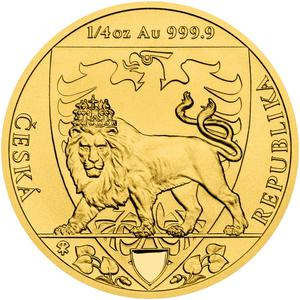
The rulers of Bohemia originally bore for arms a so-called St. Wenceslas flaming eagle. In the 12th century, Emperor Frederick granted new arms to King Vladislaus II consisting of a silver lion on a red field, to symbolise his valour. The lion was at first represented with one tail. Later a second tail was added, for the help provided by the King Přemysl Otakar I fighting the Saxons (this is just a legend though, from Dalimil's chronicle).
The lion has been displayed on the Coat of Arms of the Kingdom of Bohemia (including when it was part of the Austro-Hungarian Empire), Czechoslovakia, the Protectorate of Bohemia and Moravia, and now on the Coat of Arms of the Czech Republic (since 1990). In the Greater version of the Coat of Arms, the lion is displayed on two of the four quarters of the shield. The Lesser version is "a red shield, in it a silver double-tailed lion rampant with golden crown and golden armament".
On coinage, only the crowned double-tailed lion is shown - without the shield.
The Czech Mint also has a series of bullion coins featuring the Czech Lion which is issued under the authority of Niue; on these coins, the lion is on the reverse and the obverse display the British monarch.
| 


